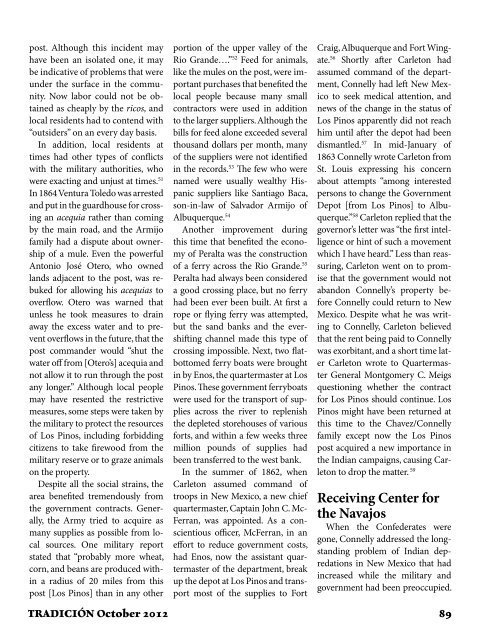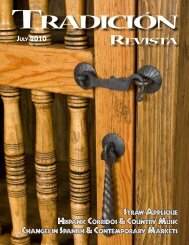tradicion revista fall 2012 - LPD Press & Rio Grande Books
tradicion revista fall 2012 - LPD Press & Rio Grande Books
tradicion revista fall 2012 - LPD Press & Rio Grande Books
You also want an ePaper? Increase the reach of your titles
YUMPU automatically turns print PDFs into web optimized ePapers that Google loves.
post. Although this incident may<br />
have been an isolated one, it may<br />
be indicative of problems that were<br />
under the surface in the community.<br />
Now labor could not be obtained<br />
as cheaply by the ricos, and<br />
local residents had to contend with<br />
“outsiders” on an every day basis.<br />
In addition, local residents at<br />
times had other types of conflicts<br />
with the military authorities, who<br />
were exacting and unjust at times. 51<br />
In 1864 Ventura Toledo was arrested<br />
and put in the guardhouse for crossing<br />
an acequia rather than coming<br />
by the main road, and the Armijo<br />
family had a dispute about ownership<br />
of a mule. Even the powerful<br />
Antonio José Otero, who owned<br />
lands adjacent to the post, was rebuked<br />
for allowing his acequias to<br />
overflow. Otero was warned that<br />
unless he took measures to drain<br />
away the excess water and to prevent<br />
overflows in the future, that the<br />
post commander would “shut the<br />
water off from [Otero’s] acequia and<br />
not allow it to run through the post<br />
any longer.” Although local people<br />
may have resented the restrictive<br />
measures, some steps were taken by<br />
the military to protect the resources<br />
of Los Pinos, including forbidding<br />
citizens to take firewood from the<br />
military reserve or to graze animals<br />
on the property.<br />
Despite all the social strains, the<br />
area benefited tremendously from<br />
the government contracts. Generally,<br />
the Army tried to acquire as<br />
many supplies as possible from local<br />
sources. One military report<br />
stated that “probably more wheat,<br />
corn, and beans are produced within<br />
a radius of 20 miles from this<br />
post [Los Pinos] than in any other<br />
portion of the upper valley of the<br />
<strong>Rio</strong> <strong>Grande</strong>….” 52 Feed for animals,<br />
like the mules on the post, were important<br />
purchases that benefited the<br />
local people because many small<br />
contractors were used in addition<br />
to the larger suppliers. Although the<br />
bills for feed alone exceeded several<br />
thousand dollars per month, many<br />
of the suppliers were not identified<br />
in the records. 53 The few who were<br />
named were usually wealthy Hispanic<br />
suppliers like Santiago Baca,<br />
son-in-law of Salvador Armijo of<br />
Albuquerque. 54<br />
Another improvement during<br />
this time that benefited the economy<br />
of Peralta was the construction<br />
of a ferry across the <strong>Rio</strong> <strong>Grande</strong>. 55<br />
Peralta had always been considered<br />
a good crossing place, but no ferry<br />
had been ever been built. At first a<br />
rope or flying ferry was attempted,<br />
but the sand banks and the evershifting<br />
channel made this type of<br />
crossing impossible. Next, two flatbottomed<br />
ferry boats were brought<br />
in by Enos, the quartermaster at Los<br />
Pinos. These government ferryboats<br />
were used for the transport of supplies<br />
across the river to replenish<br />
the depleted storehouses of various<br />
forts, and within a few weeks three<br />
million pounds of supplies had<br />
been transferred to the west bank.<br />
In the summer of 1862, when<br />
Carleton assumed command of<br />
troops in New Mexico, a new chief<br />
quartermaster, Captain John C. Mc-<br />
Ferran, was appointed. As a conscientious<br />
officer, McFerran, in an<br />
effort to reduce government costs,<br />
had Enos, now the assistant quartermaster<br />
of the department, break<br />
up the depot at Los Pinos and transport<br />
most of the supplies to Fort<br />
Craig, Albuquerque and Fort Wingate.<br />
56 Shortly after Carleton had<br />
assumed command of the department,<br />
Connelly had left New Mexico<br />
to seek medical attention, and<br />
news of the change in the status of<br />
Los Pinos apparently did not reach<br />
him until after the depot had been<br />
dismantled. 57 In mid-January of<br />
1863 Connelly wrote Carleton from<br />
St. Louis expressing his concern<br />
about attempts “among interested<br />
persons to change the Government<br />
Depot [from Los Pinos] to Albuquerque.”<br />
58 Carleton replied that the<br />
governor’s letter was “the first intelligence<br />
or hint of such a movement<br />
which I have heard.” Less than reassuring,<br />
Carleton went on to promise<br />
that the government would not<br />
abandon Connelly’s property before<br />
Connelly could return to New<br />
Mexico. Despite what he was writing<br />
to Connelly, Carleton believed<br />
that the rent being paid to Connelly<br />
was exorbitant, and a short time later<br />
Carleton wrote to Quartermaster<br />
General Montgomery C. Meigs<br />
questioning whether the contract<br />
for Los Pinos should continue. Los<br />
Pinos might have been returned at<br />
this time to the Chavez/Connelly<br />
family except now the Los Pinos<br />
post acquired a new importance in<br />
the Indian campaigns, causing Carleton<br />
to drop the matter. 59<br />
Receiving Center for<br />
the Navajos<br />
When the Confederates were<br />
gone, Connelly addressed the longstanding<br />
problem of Indian depredations<br />
in New Mexico that had<br />
increased while the military and<br />
government had been preoccupied.<br />
TRADICIÓN October <strong>2012</strong> 89




